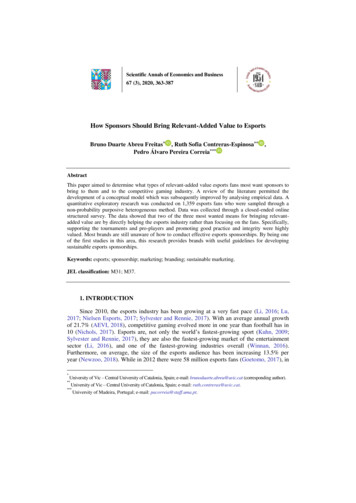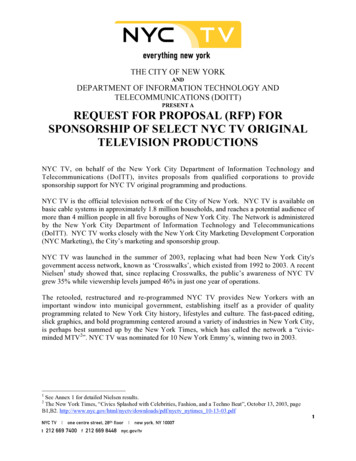
Transcription
Scientific Annals of Economics and Business67 (3), 2020, 363-387How Sponsors Should Bring Relevant-Added Value to EsportsBruno Duarte Abreu Freitas* , Ruth Sofia Contreras-Espinosa**Pedro Álvaro Pereira Correia***,AbstractThis paper aimed to determine what types of relevant-added value esports fans most want sponsors tobring to them and to the competitive gaming industry. A review of the literature permitted thedevelopment of a conceptual model which was subsequently improved by analysing empirical data. Aquantitative exploratory research was conducted on 1,359 esports fans who were sampled through anon-probability purposive heterogeneous method. Data was collected through a closed-ended onlinestructured survey. The data showed that two of the three most wanted means for bringing relevantadded value are by directly helping the esports industry rather than focusing on the fans. Specifically,supporting the tournaments and pro-players and promoting good practice and integrity were highlyvalued. Most brands are still unaware of how to conduct effective esports sponsorships. By being oneof the first studies in this area, this research provides brands with useful guidelines for developingsustainable esports sponsorships.Keywords: esports; sponsorship; marketing; branding; sustainable marketing.JEL classification: M31; M37.1. INTRODUCTIONSince 2010, the esports industry has been growing at a very fast pace (Li, 2016; Lu,2017; Nielsen Esports, 2017; Sylvester and Rennie, 2017). With an average annual growthof 21.7% (AEVI, 2018), competitive gaming evolved more in one year than football has in10 (Nichols, 2017). Esports are, not only the world’s fastest-growing sport (Kuhn, 2009;Sylvester and Rennie, 2017), they are also the fastest-growing market of the entertainmentsector (Li, 2016), and one of the fastest-growing industries overall (Winnan, 2016).Furthermore, on average, the size of the esports audience has been increasing 13.5% peryear (Newzoo, 2018). While in 2012 there were 58 million esports fans (Goetomo, 2017), in*University of Vic – Central University of Catalonia, Spain; e-mail: brunoduarte.abreu@uvic.cat (corresponding author).**University of Vic – Central University of Catalonia, Spain; e-mail: ruth.contreras@uvic.cat.***University of Madeira, Portugal; e-mail: pacorreia@staff.uma.pt.
364Abreu Freitas, B. D., Contreras-Espinosa, R. F., Pereira Correia, P. Á.2018, that number had already increased to 395 million (Statista, 2019), and it is expectedthat by 2020 there will be over 500 million esports fans (BI Intelligence and Elder, 2017;Shabir, 2017). More importantly, this does not seem to be a passing fad since this growthrate shows no signs of slowing down (Sylvester and Rennie, 2017). As can be seen, theesports industry is very resilient (Shabir, 2017; Ströh, 2017), even Matt Wolf, responsiblefor the gaming section of Coca-Cola, has stated that esports are sustainable (Lu, 2017).Yet, esports’ extremely accelerated growth has made it impossible for the scientificcommunity to keep up with its advancements (Franke, 2015; Lokhman et al., 2018). Because ofthis, very little is known about the esports market (Seo, 2013; Franke, 2015) and especially itssponsorships (Chalmet, 2015; Bouaoui, 2016; Korpimies, 2017). Furthermore, esports are verydifferent from sports (Ströh, 2017). Thus, implementing current sport sponsorship strategies inesports is not a reliable option (Burton, 2017). The general sponsorship strategies do not translatewell to esports (Burton, 2017; Ströh, 2017) and can oftentimes lead to some very negative resultswith strong flashbacks from the young esports community who can easily detect commerciallypredatory brands (Winnan, 2016). This means that there are no specific guidelines for how toconduct effective and efficient sponsorships in the competitive gaming market.According to Shabir (2017), the large popularity of esports means that fans are enjoyingmore than 400 annual tournaments and vast arrays of content. However, the author alsostresses that traditional advertising methods, such as native advertisements, banners and otherinvasive ads, which took the internet by storm during the 2000s, are now despised, being oneof the least effective means of advertising. The contemporary internet user no longer acceptsinvasive ads, which has led to the popularization of ad-blockers (Shabir, 2017). To avoid this,some brands place their logos on the sponsored party’s website or on the pro-players’ jerseys(Taylor, 2012). Yet, such rudimentary advertising (BI Intelligence and Elder, 2017) and simplemedia exposure (Ströh, 2017), like basic logo placements, do not suffice (Shabir, 2017).Brands are not able to reach esports fans through such plain and self-focused advertising (BIIntelligence and Elder, 2017). The esports community wants to be heard, entertained, and seebrands making an actual effort to improve the overall esports scene (Shabir, 2017).In this sense, esports sponsors must seek more integrated, novel (Burton, 2017), andhighly creative strategies to effectively reach esports fans (Winnan, 2016; Burton, 2017;Shabir, 2017). Although fans understand that the sponsors’ main goal is commercialsuccess, they believe that their second objective should be altruistic. If a brand only showsfinancial interest, it will not be well perceived (Ströh, 2017). Hence, and as stated by Steinand Scholz (2016), it is vital that brands show an intrinsic love and motivation to supportesports. The author emphasises that this is what drives the industry. The people in esportsare dedicating their lives to make this market grow and it is expected that brands will also dothe same (Stein and Scholz, 2016). Thus, to effectively engage them, sponsors must bringrelevant-added value to esports (Shabir, 2017; Ströh, 2017).Shabir (2017) presents a study by the Esports Ad Bureau and the Magid Advisors whichconcluded that 72% of fans want sponsorships to bring value to the industry. Based on theauthor, this is not related to the simple value of monetary influx in exchange for brandvisibility. Besides the basic value of financial support, Shabir stresses that esports fans wantsponsors to provide relevant-added value. To provide relevant-added value, the sponsorsthemselves must contribute to the growth of the esports industry (Shabir, 2017) or performactivities that actually enhance the fans’ experience (Seo, 2013). According to Shabir (2017),some specific examples of sponsors adding relevant-added value would be: promoting
Scientific Annals of Economics and Business, 2020, Volume 67, Issue 3, pp. 363-387365competitiveness, providing meaningful opportunities for the community, and helping putesports closer to the mainstream culture. That is, brands must show an actual effort to improvethe scene (Shabir, 2017), which means that they must also convince their stockholders thatphilanthropy is vital to gain larger and long-term ROIs (J. L. Crompton, 2015).Furthermore Burton (2017) notes that the sponsorships must logically connect thebrand’s products with the esports culture. According to the author, esports fans are open tosponsorships as long as they make sense and make the brand an integral component of thescene. If the sponsorship shares the fans’ particular interests, it will reach them (Burton,2017). Likewise, Shabir (2017) points out that fans know that esports are a young industryand that it needs the help from sponsors to grow, so they welcome brands that make an extraeffort to improve this market. By having the philanthropic intention of being part of thecause and improving the fans’ experience and the esports industry itself, the sponsor will bea beloved part of the movement (Shabir, 2017). Bearing in mind the importance of bringingrelevant-added value to esports, this research aimed at developing the first conceptual andempirical models of how sponsors should bring relevant-added value to esports.Numerous sponsors have been highly successful because they brought relevant-addedvalue to esports (Seo, 2013; Ströh, 2017). Among the benefits of bringing value, brands canexpect to be perceived as an integral and relevant component of the scene (Ströh, 2017),which will improve the fans’ attitudes (The Nielsen Company, 2015; Shabir, 2017; Ströh,2017) and mitigate any doubts about the sponsors’ sole financial interests (Winnan, 2016;Ströh, 2017). Moreover, this will make them reach a larger target-market (Ströh, 2017), gainconsiderable coverage (CGC Europe, 2015), enhance the brand’s chances of having asustainable sponsorship (Stein and Scholz, 2016), and harvest other substantial ROIs(Shabir, 2017; Ströh, 2017). And this can be done through relatively low investments (Ströh,2017). In short, by raising their altruistic involvement in the scene and improving the fans’experience, sponsors will obtain considerable rewards (Seo, 2013). Thus, the followingresearch question will explore how sponsors can bring relevant-added value to esports:RQ: What marketing strategies can esports sponsors implement to bring relevant-addedvalue to the esports industry and its fans?2. LITERATURE REVIEW2.1 Present relevant advertisements to fansAll advertisements must provide relevant information (Parreño et al., 2013) or offers tofans (CGC Europe, 2015), like limited-time offers (Parreño et al., 2013) or productdiscounts (Shabir, 2017). As stated by Parreño et al. (2013), if an ad is perceived as useful,the probability of irritation will be much lower. Because of this, brands must carefullyponder about the perceived usefulness of their ads (Parreño et al., 2013).Parreño et al. (2013) notes that the entertainment element of ads must also be improved.The author mentions that, the more entertaining an ad, the more positive the consumers’ attitudeswill be. Therefore, brands must implement entertainment-based advertising (Parreño et al.,2013). Likewise, Lancaster and Massingham (2018) state that captivating or humorousadvertisements increase brand equity. Specifically, the brand becomes deeply engraved inconsumers’ minds and they will develop more positive opinions of the brand, which willpotentially lead to increased sales and brand loyalty (Lancaster and Massingham, 2018).
366Abreu Freitas, B. D., Contreras-Espinosa, R. F., Pereira Correia, P. Á.2.2 Provide relevant content to fansIt is very important that sponsors provide esports fans with relevant and interestingcontent (Winnan, 2016; Shabir, 2017; Ströh, 2017). In fact, all brands that wish to enteresports must present relevant content (Ströh, 2017). Shabir (2017) provides two examples ofbrands creating relevant-added value for esports. The first is focused on the Totino’s brandwho, during an Intel Extreme Masters tournament, created a challenge where attendees hadto sit on a mechanical moving couch, and avoid falling from it, while playing a videogame.The second example, is focused on Coca-Cola who usually has given event attendees cheerboards to write messages on, hosted viewing parties at cinemas for important tournamentsfor those who cannot personally attend, and partnered with Riot Games to provide drinksduring League of Legends tournaments. Other authors have also provided examples ofbrands creating relevant-added value for esports. For instance, according to Taylor (2012),besides sponsoring the World Cyber Games, the Shinhan Bank created a bank account,named Star League Mania, which provided its users with V.I.P. seats for the World CyberGames’ finals, giving fans a privileged experience. According to Keiper et al. (2017), RedBull established a section in its company focused on esports coverage. And according toCGC Europe (2015), HyperX created an array of high-quality content for fans, includinghumorous videos with celebrities and esports news and insights. The author notes that theircontent was not composed of generic humour and facts. HyperX showed a deep knowledgeof the scene, including the fans’ lingo and inside jokes, which made their content feelauthentic, and not artificial, and allowed HyperX to catch the attention of a massiveaudience (CGC Europe, 2015).When people are able to experience the brand in a direct, interactive and flow-likemanner, they develop much higher brand awareness and recall, and more positive attitudes,often perceiving it as more pleasant and exciting than one that simply shows a logo (Fransen etal., 2013). Flow can be understood as the positive feeling that manifests when people arecompletely and directly involved with an activity (Csikszentmihalyi, 2014). Thus, anaccording to Fransen et al. (2013), direct brand experiences are very impactful. The authorsstate that brands should also focus on social experiences as individual ones are less effective.People must feel that they are all integral elements of a shared social experience. These aspectsdemonstrate the importance of flow. As stated by the authors, brand encounters with activeflow experiences are likely to have a positive impact on people’s emotions. This allows thebrand to prevent consumer scepticism, bypass rational information pathways and directly enterthe consumers’ mind, highly engraving the brand in the people’s minds and enhancing brandrecall and positive attitudes. These flow experiences are even possible though the internet aswebsite interactivity can boost several dimensions of flow, like absentmindedness, control,concentration, engagement, and curiosity (Fransen et al., 2013).2.3 Focus on storytellingStorytelling is a vital marketing tool (Grzesiak, 2018). It is the selling point of anytournament, including esports (Borowy, 2012). Stories around an old-time veteran versus apromising rookie (Taylor, 2012), of favourite versus underdog, of evil versus kind (Borowy,2012), or of a losing team making a comeback (Demers, 2015) are very effective at grabbingthe crowd’s attention (Borowy, 2012; Taylor, 2012). As stated by Taylor (2012), similar to
Scientific Annals of Economics and Business, 2020, Volume 67, Issue 3, pp. 363-387367sports, as tournaments get closer to the climax, the event is presented with increasingly moredrama and tension. The author notes that all of the teamwork, euphoria, and frustration areaspects that the audience relates to. Because of this, various media outlets (Taylor, 2012) andtournament organizers (Hamari and Sjöblom, 2017), like the Electronic Sports League (ESL);Nielsen Esports, 2017 and the Championship Gaming Series (CGS), have put a significanteffort on increasing storytelling across esports (Taylor, 2012). According to Taylor (2012),they drew attention to the drama as well as the personal and competitive aspects of the sceneand developed a narrative around teamwork, individualism, and rivalries.Commentators also play a vital role here as they are glorified storytellers with a deepknowledge (Taylor, 2012) and authentic love for esports (Demers, 2015). Commentators areable to establish captivating narratives because they have considerable knowledge about thehistory and context of esports, including of the pro-players and tournaments (Taylor, 2012).Demers (2015) states that, according to Sean “Day[9]” Plott, one of the best StarCraftcommentators, his main goal is not simply to convey excitement, but to tell a compelling storythat is strengthened through his authentic excitement, as fans can easily identify fakeenthusiasm. If a losing team makes a comeback, the fans’ attention is captured (Demers, 2015).Taylor (2012) also mentions that, according to Mike Burks, an experienced producerfrom the NBA, NHL, NFL, and esports, the main focus is not the sport itself, but the peoplewho play it. Burks states that, fans are emotionally attached to the pro-players, loving somepro-players and hating others. But he stresses that even the latter is good because, while anuninterested person will ignore that pro-player’s matches, a person who does not like him ismuch more likely to watch him play. Influencing someone to watch a player they hate is theproduct of a great storyteller (Taylor, 2012).A fine-tuned storytelling strategy in esports will raise much more brand awareness thanany classical advertising method (CGC Europe, 2015). This is in line with the words ofAndy Reif, the CEO of CGS, who stated that what will take esports to the next level is notsimply the right production values, it is also the right storytelling (Taylor, 2012). Forinstance, the Ginx brand is focused on creating stories by interviewing pro-players, showinghow things look like in the backstage of major tournaments, and by creating documentaries(Rogers, 2018). According to Lim (2018), Mastercard, the main sponsor of one of 2018’sbiggest esports tournaments (i.e. the League of Legends World Championship), is looking togo even beyond storytelling and embrace story-making. Specifically, Mastercard wants toprovide fans with experiences that enable them to create their own stories and become fansof the brand. Instead of simply showing a number of advertisements, they are deliveringexperiences to fans. The author notes that, by placing fans close to what they love, they willcreate unforgettable stories, which will be shared online and with their friends. Someexamples of these experiences include: allowing select fans to attend opening ceremonyrehearsals, augmented reality experiences, behind-the-scenes tours, and other ways ofengaging fans through what they love (Lim, 2018).The popularity of storytelling is justified by its various benefits (Trigoni, 2016).Especially, the power to rise above all the advertising clutter and draw consumer attention(Walter and Gioglio, 2014). Consumers will be connected with the brand because the narrativewill create conversations between them and the brand, which will increase brand recall (Singhand Sonnenburg, 2012). This is because humans are not good at remembering facts, unlessthey are delivered in a narrative form (Pikos and Olejniczak, 2016; Grzesiak, 2018). If thebrand is an integral element of the story, then it will always be on the audience’ mind (Trigoni,
368Abreu Freitas, B. D., Contreras-Espinosa, R. F., Pereira Correia, P. Á.2016). Essentially, a good story will make your content more attractive (Pikos and Olejniczak,2016), attract consumers, enhance their familiarity with the brand (Y.-s. Lee and Shin, 2015),give meaning (Singh and Sonnenburg, 2012) and improve the brand image Grzesiak, 2018,and keep fans emotionally engaged (Y.-s. Lee and Shin, 2015; Shabir, 2017). Still, it is vitalthat the stories and the pro-players’ personas be real, they must not be enforced upon them.Esports should avoid the theatricality of wrestling (Taylor, 2012).2.4 Perform product trialAs reported by McCarville et al. (1998), product trial is very important and is amongthe most effective sponsorship strategies. It is highly efficient at stimulating people’s sensesand provides immediate satisfaction to consumers (McCarville et al., 1998). Mostimportantly, product trial can greatly benefit the adoption process because consumers like toexperience a product prior to deciding if they should buy it (Wood, 2017). There are severalpeople who wanted to try a particular product but never had the chance to do it (J.Crompton, 1994). Thus, various brands use events to encourage these trials as they are quiteeffective at encouraging non-users to consume the brand’s products or at ensuring thatexisting customers continue using them (Masterman and Wood, 2005). According toMcDonnell and Moir (2014), it is quite difficult to turn people who are just interested in aproduct into individuals who actually desire it. But, giving people the chance to experimenta product free of costs is a very effective way of achieving this (McDonnell and Moir,2014). In general, an enjoyable product trial will lead to positive word of mouth (Mastermanand Wood, 2005), increased brand awareness (Kotler and Keller, 2016) and sales(Masterman and Wood, 2005; Fahy and Jobber, 2015), and has a higher chance of leading tolong-term use of the product than regular advertising (Belch and Belch, 2018).During offline esports tournaments, it is common for brands to use demo booths(Taylor, 2012) to showcase their products or provide samples (Winnan, 2016). For instance,the main sponsor of the 2010 World Cyber Games, Samsung, used the event to demonstrateseveral of its products, including tablets, smartphones, and monitors (Borowy, 2012).During some ESL offline tournaments, Zowie placed booths where attendees could try theirnewest gaming peripherals and add-ons (Ströh, 2017). And, according to Shabir (2017),during an Intel Extreme Masters in Oakland, Intel allowed fans to try out several of itsproducts, including experiences in virtual reality. In the same event, Totino’s also providedattendees with free samples of their pizza products (Shabir, 2017).Product trial can also be used to improve the brand’s products (Taylor, 2012). It iscommon for brands to use product trials to evaluate consumers’ reactions and even test theirproducts in real-world settings (Winnan, 2016). For example, as stated by Taylor (2012),gaming peripheral esports sponsors, like SteelSeries, ask pro-players to try, and providefeedback, on the quality of their upcoming products to ensure that, when released, they willhave the required qualities to be used by the best of the best. In this sense, SteelSeries canpublicise their products as being fit for the top pro-players (Taylor, 2012). This will attractseveral esports fans (Winnan, 2016) who want more esports merchandise (Franke, 2015)and are willing to spend large sums on top quality products (Winnan, 2016).
Scientific Annals of Economics and Business, 2020, Volume 67, Issue 3, pp. 363-3873692.5 Support tournaments and pro-playersSponsors should do their best to support tournaments and pro-players beyond theexpected monetary backing (Shabir, 2017). When fans perceive that the sponsor issupporting the industry they love, they will develop much more positive attitudes toward thebrand (Ströh, 2017). This has led several companies to support the industry (Shabir, 2017).For instance, Red Bull created the Red Bull Battle Grounds tournament (Härig, 2015) andbuilt a training facility for pro-players (Winnan, 2016). Monster Energy provides proplayers with free cans of their energy drink during tournaments (Li, 2016). According toShabir (2017), Gillette has provided free grooming services to pro-players during an IntelExtreme Masters tournament and allowed them (and fans) to customize and keep a 3Dprinted razor. The author also notes that Coca-Cola partnered with EA Sports to develop theeCOPA Coca-Cola. A tournament for amateur FIFA players where the winners qualify toparticipate in the professional FIFA tournaments and earn a scholarship (Shabir, 2017).Based on Gifford (2017), even the South Korean Air Force has brought value toesports. In 2007, they formed The Ace Team to allow professional StarCraft players tocontinue competing when performing South Korea’s two years of mandatory militaryservice (Gifford, 2017). Seo (2013) mentions that the airline brand, Korean Air, also madean effort to become an integral component of the industry and improve the scene. Accordingto the author, in 2010, it hosted the finals of a major StarCraft tournament on its hanger andwrapped images of the videogame’s characters on two of its airplanes. Korean Air statedthat this served to show their continuous effort to support esports (Seo, 2013).2.6 Promote good practice and integrityThe esports industry is still in its infancy (Gainsbury et al., 2017; Keiper et al., 2017;Shabir, 2017; Ströh, 2017; AEVI, 2018) and needs help to grow (Winnan, 2016). Hence, allentities within esports should do their best to improve this industry (AEVI, 2018), and thisincludes sponsors, who should promote good practices and integrity in esports (Brickell,2017). This should be one of their main goals as it will erase the possibility of their brandsbeing associated with acts of disreputable behaviour (Ströh, 2017), which can have a verynegative effect on the brands (Stivers, 2017). Furthermore, this will prevent people fromlosing faith in the legitimacy of esports (Sylvester and Rennie, 2017).It is essential that sponsors instruct people to comply with the codes of conduct andregulations, require stronger integrity measures, and promote cooperation among all esportsentities (Brickell, 2017). Organizations like the Esports Integrity Coalition (ESIC) havemade strong efforts to promote the integrity of esports, fight corruption (Ströh, 2017) anddoping (Mooney, 2018), standardise the codes of conduct, regulate esports, etc. (Sylvesterand Rennie, 2017). The ESL, the Nationale Anti Doping Agentur, the World Anti-DopingAgency (WADA); Stivers (2017); Ströh (2017) and the International Esports Federation(IeSF) are all working hard to fight doping in esports (Ströh, 2017; IeSF, n.d.). Entities likethe United Kingdom Gambling Commission (Griffiths, 2017, Ströh, 2017), the ESL andSportradar are doing their best to fight illegal and unregulated gambling (Winnan, 2016).And ESIC has published several codes of conduct and even a disciplinary procedure foroffenders (Shabir, 2017). This led several brands, like Intel, Betway (Ströh, 2017) and ESL,to abide by their code and make efforts to promote esports’ integrity (Mooney, 2018). But
370Abreu Freitas, B. D., Contreras-Espinosa, R. F., Pereira Correia, P. Á.ESIC is still a very recent organization and does not have a large jurisdiction in the industry(Brickell, 2017).The entire esports industry must cooperate to erase cheating and corruption fromesports (Sylvester and Rennie, 2017). Sponsors especially must do their best to minimizecorruption as this can also negatively affect their brands (Manoli, 2018). The presence ofcheaters, for instance, can cause severe problems to the sponsors’ public relations (Stivers,2017). In regular sports, it is common for sponsors to withdraw their partnerships if thesponsored party is found to have engaged in any sort of wrongdoings (Manoli, 2018).Because cheating can negatively affect every esports entity, there can be no room mercy orforgiveness (Christophers, 2011).Everyone in esports must also do their best to prevent all acts of discrimination andprovide equal inclusion rights for everyone (AEVI, 2018). For example, according toMooney (2018), in an effort to increase the small number of female pro-players (who oftendo not compete due to sexism issues), Bandai Namco created tag team tournaments whereeach team had to be composed of one male and one female pro-player. They are alsoplanning on implementing female pro-players training programmes to increase the numberof women in esports (Mooney, 2018). In the same vein, brands like Ubisoft have sponsoredfemale pro-teams, like the Frag Dolls (Li, 2016). Sponsoring female players will create rolemodels for women and attract more female fans and pro-players (Winnan, 2016). Lastly, itis also important to inform people that, just like with McDonald’s, doughnuts, etc., theexcessive play of videogames is unhealthy (Shabir, 2017).2.7 Promote gaming’s acceptanceThere is a myriad of misconceptions that haunt gamers (Shabir, 2017). They areperceived as nerds (Winnan, 2016), and various politicians, academics, parent groups, andmedia have stated that gaming leads to aggressiveness, obesity, social isolation (Crawfordand Gosling, 2009) and addiction (Nielsen and Karhulahti, 2017). But there is little evidenceto support these claims (Crawford and Gosling, 2009; Franke, 2015). In reality, thecondemnation of gaming is based in part on ignorance (Hilvoorde, 2016). The logic behindthe criticisms toward gaming is extremely flawed and depicts games and gamers quitegrotesquely (Newman, 2008). For example, the dedication of pro-players to their careersshould not be confused with addiction (Nielsen and Karhulahti, 2017). According to Shabir(2017), both athletes and pro-players can spend up to 10 hours per day training. Similarly,regarding the excessive exposition to screens and sitting, the same can be said for themillions of people whose work consists of sitting in a chair looking at screens for 8 hoursper day (Shabir, 2017). Furthermore, Ströh (2017) notes that esports are not a solitaryactivity, they are a social one. Fans communicate between themselves (Ströh, 2017). In fact,for this community, the main attraction of esports is not the competition, it is the socialinteractions (Peša et al., 2017). Research has even shown that esports increase people’ssocial embeddedness (Domahidi et al., 2014) and the success of a pro-team is extremelydependant on communication and cooperation (Parkin, 2015; Li, 2016). Lastly, videogamescan also be educative (Steinkuehler, 2016).Nevertheless, these criticisms are so voracious and persistent (Newman, 2008) thatcorrective measures must be implemented (Newman, 2008; AEVI, 2018). Bearing in mind therate at which esports is growing and the size it already has, it is very important to drop these
Scientific Annals of Economics and Business, 2020, Volume 67, Issue 3, pp. 363-387371outdated stereotypes and make society aware that esports are a serious and international sportand an economic powerhouse with hundreds of millions of fans (Ströh, 2017). Fortunately, thepublic’s negative perception of videogames has been decreasing thanks to the help of somesponsors and other entities (Shabir, 2017). CGS has shown multiple videos refuting severalnegative assumptions about esports (Taylor, 2012), while also highlighting the passion andenergy of the scene (Li, 2016). And, according to Shabir (2017), multiple other esportssponsors have also been working hard to promote gaming’s acceptance. With everyone’s help,it may be possible to improve gaming’s image (Shabir, 2017).3. METHODOLOGYThrough the literature review, it was possible to identify seven main tools that sponsorscan use to bring relevant-added value to esports. Figure no. 1 provides a conceptu
Besides the basic value of financial support, Shabir stresses that esports fans want sponsors to provide relevant-added value. To provide relevant-added value, the sponsors themselves must contribute to the growth of the esports industry (Shabir, 2017) or perform activities that actually enhance the fans' experience (Seo, 2013).










